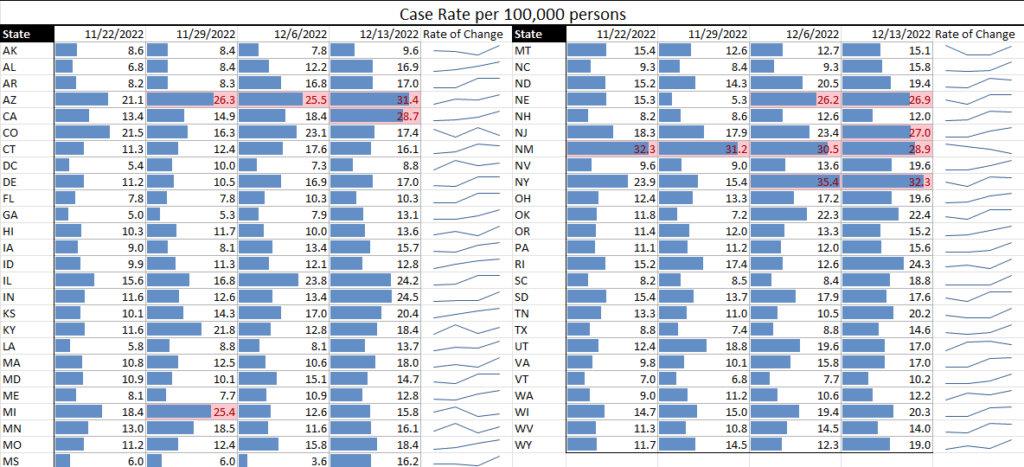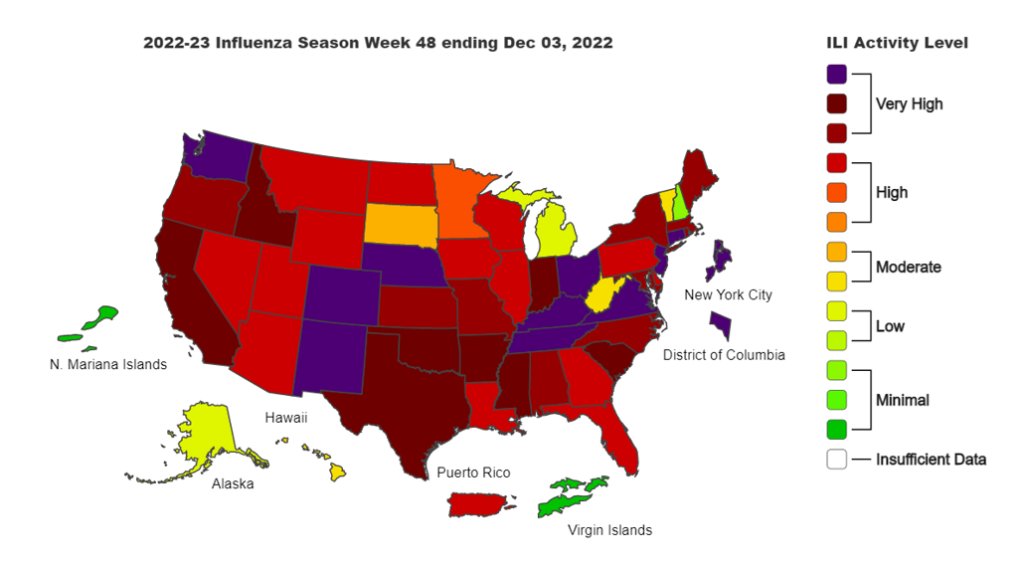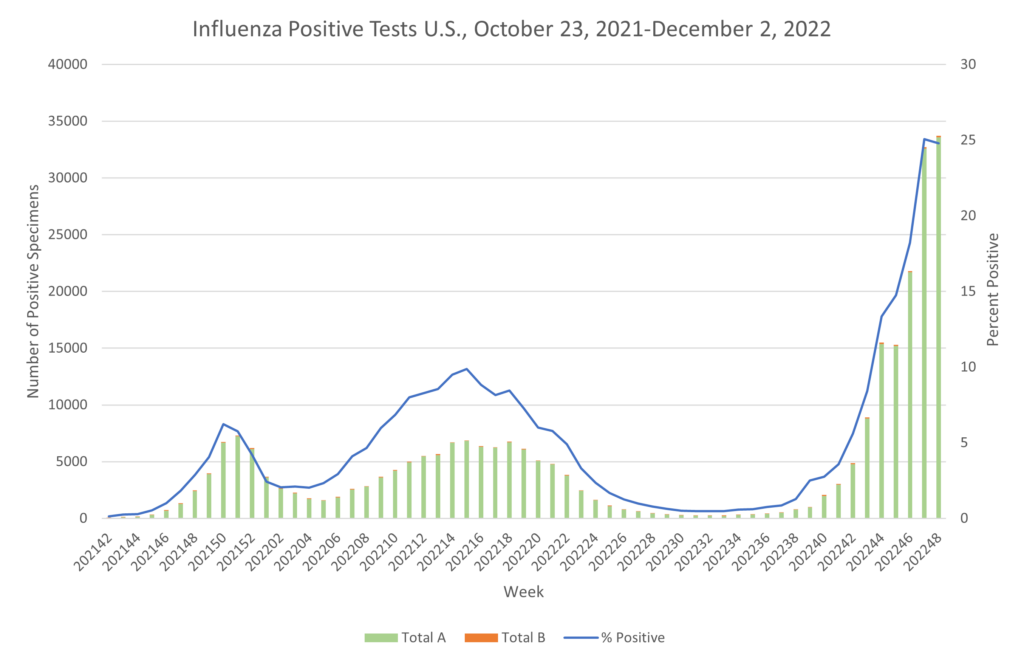Not only is influenza (“the flu”) continuing to spread across the U.S., but its reach has also extended across the entirety of the United States, except for New Hampshire. While we’ve previously discussed the different spreading flu types, in the U.S., the predominant flu strain continues to be Influenza A. Running parallel to the rise in influenza, there is an increased rise of U.S. COVID cases (driven by two main variants BQ1 & BQ1.1), which, coupled with the increase of COVID-related hospitalizations, could signal the start of a new COVID season. According to the CDC, the highest county-level transmissions are being seen in Arizona and western Montana.
On a global scale, the rise of influenza and COVID would signal that we have entered the winter season (in the Northern Hemisphere). Per our previous discussions, vaccinations are vital in reducing the transmission of infectious diseases (including influenza, COVID, measles, and even Hepatitis A). The updated COVID booster has been approved for children as young as 6 months of age. Guidelines for vaccinations are discussed in the news.
COVID Risk Matrix:



Influenza:


Infectious Disease News
- Ebola. As of Dec 7, no confirmed cases and deaths of Sudan Ebolavirus disease have been reported from Uganda since Nov 27th. The last confirmed case was diagnosed on 13 November, except for a stillborn baby on November 27th whose mother had already recovered. Cumulatively, 142 confirmed cases and 55 confirmed deaths (CFR: 38.7%) have been reported. Healthcare workers account for 13.3% (19) of the cases and 12.7% (7) of all deaths (CFR: 36.8%). The aggressive containment efforts that led to the waning of the outbreak means a quickly arranged trial of experimental vaccines faces formidable hurdles since the number of potential participants is dwindling. But they may be able to stage a phase 1 safety study of the IAVI/Merck vaccine—most likely in health care workers – in whom they’d monitor antibody development.
- Influenza. Cases are increasing in the US, but also in Europe, France, Germany, Saudi Arabia, and Canada. However, there are some other considerations, signaling that data need to be examined carefully: Hospital cases of influenza in England are up almost 50 percent in a week as the illness circulates more widely among the population, figures show. However, in England, the overall level of flu is still estimated to be below the same point three years ago, in the pre-COVID winter of 2019-2020. Flu cases are going down in Alabama. The Alabama Department of Public Health reports 6.1% of patient visits were related to the flu last week. That’s down from 7.5% the week before. However, the number of flu-related deaths did go up significantly, to 24, including three kids. Recommendations to get vaccinated, stay home when ill and practice infection control measures, such as hand washing, continue to be encouraged to help minimize risks from respiratory viruses. Vaccine development is evolving. Using the mRNA technology that proved so successful in the COVID pandemic, researchers at the U Penn have developed an experimental flu vaccine that, in tests on mice and ferrets, appears to fight the entire family of influenza viruses.
- There’s currently an outbreak of canine flu known as H3N2 happening around the country. Occurring mostly in over-crowded animal shelters and dog boarding facilities, experts have suggested the increase in dog flu is related to human behavior post-pandemic as pet adoptions are down. Analysis shows last year’s flu vaccine was 36% protective against H3N2.
- Measles. Measles cases continue to rise in Ohio with at least 73 cases reported. Contract tracing is underway in the Columbus area. No cases have been seen in children who are fully vaccinated. Children have died from measles in India and Yemen.
- Strep. On December 9, the British health department revealed that a middle school student in Sussex, England died after being infected with type A streptococcus. Since the recent outbreak of Streptococcus type A in the UK, 16 people have died, most of them children and minors. As things get back to normal, these traditional infections that we’ve seen for many years may be circulating at greater levels. It could be a result of lower-than-normal immunity levels caused by COVID measures. Royal Belfast Hospital for Sick Children struggling to cope with demand as parents seek reassurance over Strep A. There are warns of 12 hour wait times for treatment at RBHSC for its emergency department. Individuals are being advised to seek alternative care for children whose conditions were not deemed an emergency, amid potentially fatal Strep A cases in Northern Ireland.
- COVID. Updated COVID booster for kids as young as 6 months has been approved. The FDA said children ages 6 months through 5 years who received the Moderna vaccine primary series can receive a single booster of the bivalent vaccine 2 months after completing the last dose. Regarding the Pfizer vaccine, children ages 6 months through 4 years who have not yet started their three-dose series or have not yet received the third dose in the three-dose series can receive the updated Pfizer booster as their third dose. The FDA said as part of their announcement that the monovalent (single-strain) vaccine is no longer authorized as the third dose of the three-dose series in the age-group. Children who have received the primary three-dose series of the monovalent vaccine aren’t eligible for the updated booster.





